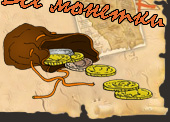
On the Dating of Different Types of Coins from Chersonesus of the Time of Mauricius (582-602) and Basil I (867-886) (I. Sokolova)
The article is a reply to two remarks, made in an article by V. Anokhin, on the classification of coins from medieval Chersonesus.
After an analysis of different delails in the pictures represented on Mauricius' coins, the author reaches the following conclusions: the coins
were minted in several issues, each one of which, with the exception of the last, included two different face-values. The coins of the first issue bear the figures M and K; those of the second bear the figures H and A, and the inscription XEPONOC; the third group bear the figures H and A and the inscription DNMAVRICPPAVC; and the fourth group, the figure H and the same inscriptions as in the third group. The coins of the fourth issue are struck on carelessly cast blanks, and the style of the devices is coarse and slipshod. The existence of several issues which show differences not only in details of type and inscription, but also of weight, points to a long period of minting; and this enables us to date the coins between the coronation of Mauricius' son Theodosius and the fall of the dynasty, i.e. between 590 and 602.
The second part of the paper deals with those coins from Chersonesus which bear the monogram Kj^ob . Certain palaeographic peculiarities (the letter R written with the horizontal stroke extending beyond both vertical lines, the omega written with a small loop above the middle element) which were common only from the ninth to the middle of the tenth century on the coins of Chersonesus, although the beta can also be found on the Byzantine seals, lead to the conclusion that there are no grounds for V. Anokhin's suggestion that coins with the monogram KROO should be redated to the time of Basil II and Constantine VIII. The coins could have been minted only during the reigns of Basil I and Constantine.
|
ПОИСК:
|
© VseMonetki.ru, 2001-2020
При использовании материалов сайта активная ссылка обязательна:
http://vsemonetki.ru/ 'Нумизматика и бонистика'
При использовании материалов сайта активная ссылка обязательна:
http://vsemonetki.ru/ 'Нумизматика и бонистика'